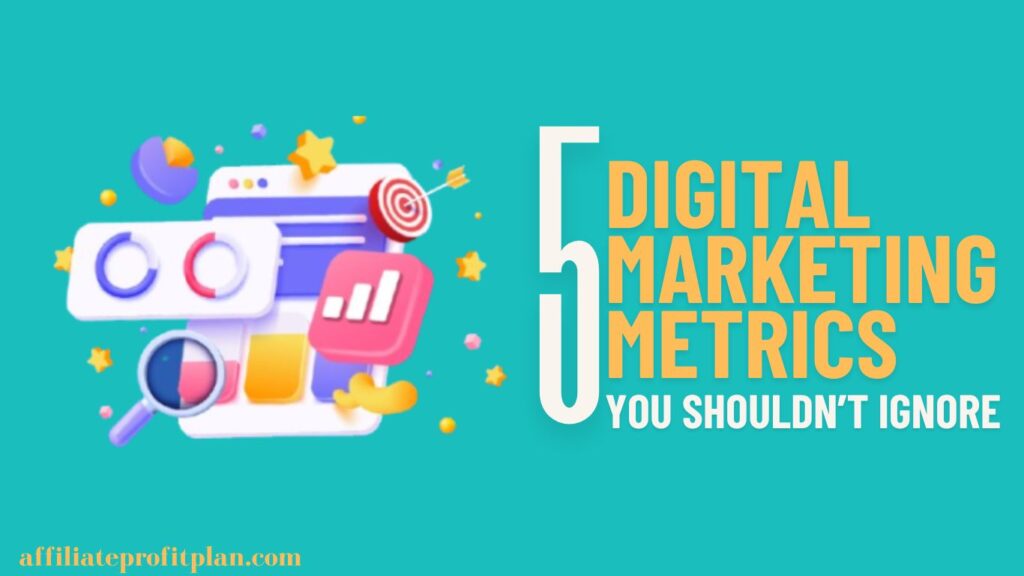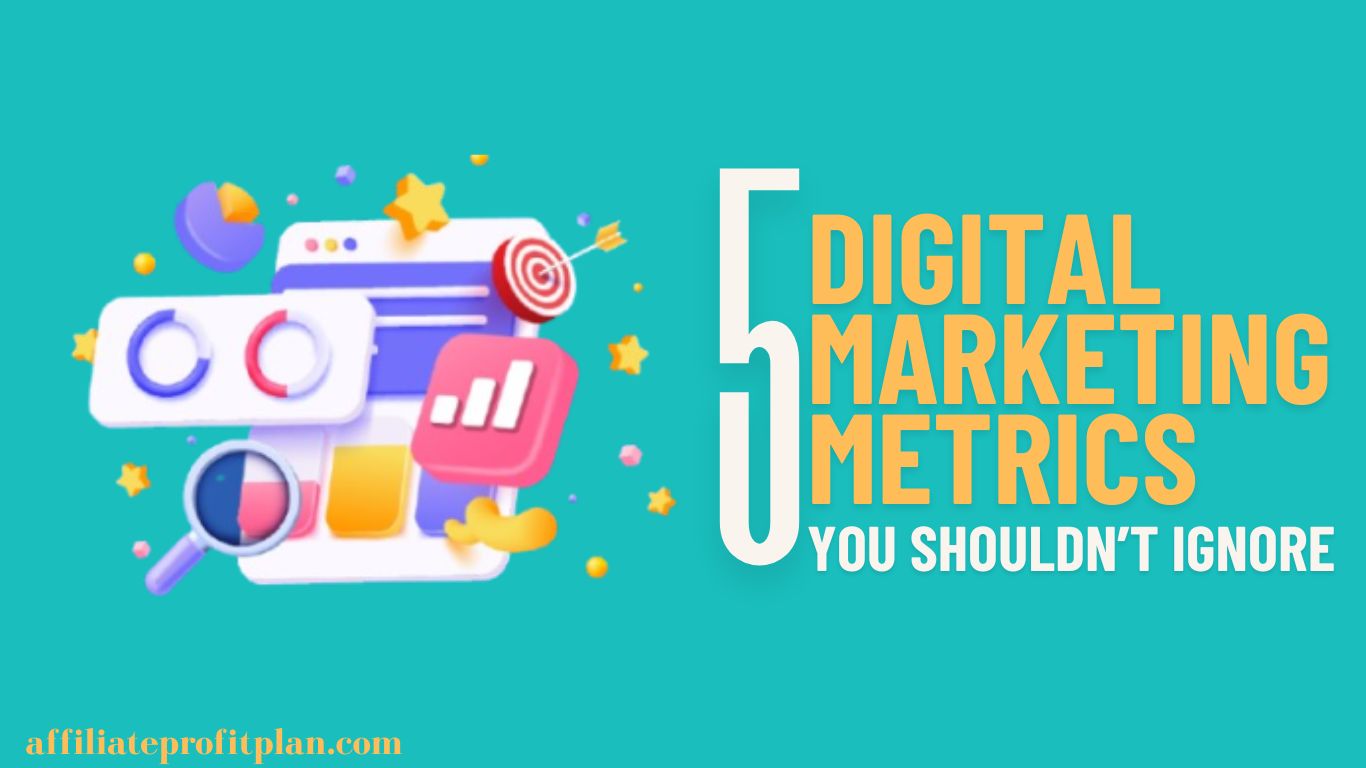Welcome to my article 5 Digital Marketing Metrics You Shouldn’t Ignore. Let’s be honest—digital marketing can sometimes feel like throwing spaghetti at the wall and seeing what sticks. Between likes, shares, bounce rates, and that one aunt who always comments “Nice!” on every post, it’s easy to get lost in a sea of numbers. But here’s the thing: not all metrics are created equal. Some are just there for vanity (looking at you, page views), while others hold the key to understanding what’s actually working—and what’s draining your budget faster than a double espresso ad spend.
In the age of algorithms and short attention spans, data-driven decisions are everything. And if you’re not tracking the right marketing metrics, you’re essentially flying blind while trying to land a jet… in a thunderstorm… with no coffee. (We wouldn’t recommend it.) The good news? You don’t need to monitor all the metrics—just the ones that truly matter. That’s where these five digital marketing metrics come in.
Whether you’re running ads, writing blog posts, sending emails, or obsessively refreshing your website traffic stats at 2 AM (we’ve all been there), these five key performance indicators (KPIs) will help you get clarity, improve performance, and most importantly—make smarter marketing moves. So, put down the vanity metrics and let’s dive into the numbers that actually move the needle.
Access My Proven Blueprint for $50-$100 Daily Income – Watch This FREE Video Now >>>

Metric #1: Customer Acquisition Cost (CAC)
Because you need to know how much you’re paying to make a sale—before your wallet cries for help.
Let’s start with one of the most essential—and misunderstood—metrics in the digital marketing universe: Customer Acquisition Cost, or CAC (pronounced “kack”… which, let’s face it, is kind of fun to say). CAC tells you how much money you’re spending to acquire just one new customer. It’s like figuring out how many dollars you’re setting on fire every time someone clicks “Buy Now.” Romantic, right?
💰 How to Calculate CAC:
The formula is simple, even if your marketing strategy isn’t:
CAC = Total Marketing & Sales Costs ÷ Number of New Customers Acquired
So if you spent $2,000 on Facebook ads, email campaigns, influencer partnerships, and your daily oat milk lattes (okay, maybe not the lattes), and you gained 20 customers, your CAC is $100. That means every shiny new customer cost you a crisp Benjamin.
🧠 Why CAC Actually Matters:
Here’s the thing—if your CAC is too high, you’re not running a business, you’re running a donation service with extra steps. On the flip side, if you can keep CAC low while increasing your customer base, you’re in golden unicorn territory. Tracking CAC helps you understand which marketing channels are pulling their weight and which ones are just eating your budget.
For example, if Instagram ads are delivering new customers at $30 a pop, but Google Ads are clocking in at $120? You’ve got a clear decision to make (and Google might need a timeout).
⚖️ Bonus Tip: Balance CAC with LTV
CAC on its own is useful, but paired with Customer Lifetime Value (LTV), it becomes downright powerful. If your CAC is $100 and your average customer is worth $300 over their lifetime, congrats—you’re doing something right. If it’s the other way around… well, time to pivot.
Bottom line? If you’re not measuring CAC, you’re guessing. And in digital marketing, guesswork is expensive. Track it. Tweak it. Then watch your profits thank you later.
Metric #2: Conversion Rate (CR)
Because traffic is great, but conversions pay the bills.
Okay, so you’ve managed to lure people to your website—nice! That’s like getting guests to show up at your party. But here’s the real question: are they just hanging out by the snack table, or are they actually dancing (i.e., signing up, buying something, or clicking that all-important CTA)? That’s where Conversion Rate steps in.
📈 What is Conversion Rate?
In plain English: your conversion rate is the percentage of visitors who do exactly what you want them to do. That “thing” could be buying a product, subscribing to your newsletter, downloading your lead magnet, or even booking a call. If they’re taking meaningful action instead of ghosting your site faster than a Tinder date, that’s a conversion.
Formula:
CR = (Conversions ÷ Total Visitors) × 100
So if 100 people visited your landing page and 5 bought your product, congrats! You have a 5% conversion rate—which, in the wild world of digital marketing, is actually pretty darn good.
🧠 Why You Should Care (A Lot):
Conversion Rate isn’t just a “nice to know” metric—it’s a performance indicator powerhouse. You could have 10,000 visitors per month, but if only 3 of them buy something, you’ve basically hosted a parade with no one throwing confetti (or cash). A higher conversion rate means you’re making more money with less traffic—and who doesn’t love that?
⚙️ How to Improve It (Without Losing Your Mind):
- Craft killer CTAs – Not just “Learn More”… we’re talking action-packed buttons like “Snag Your Spot” or “Show Me the Magic.”
- Make your site fast & mobile-friendly – Because no one likes a site that loads slower than a Monday morning.
- Use A/B testing – Headlines, colors, layouts, emojis—test them all until you find the secret sauce.
- Speak your audience’s language – Your copy should feel like a conversation, not a college thesis.
Bottom line? If you’re not watching your conversion rate, you’re just watching people leave. Start optimizing and make every click count—because in this game, it’s not just about traffic… it’s about traction.
Metric #3: Customer Lifetime Value (CLV or LTV)
Because one sale is nice, but a customer who sticks around is chef’s kiss beautiful.
Let’s talk about the metric that makes digital marketers weak in the knees: Customer Lifetime Value, also known as CLV or LTV (because marketers love acronyms almost as much as they love coffee). This little number tells you how much money a customer is likely to spend with your business over the entire course of your relationship—from the first click to their 17th purchase and everything in between.
Access My Proven Blueprint for $50-$100 Daily Income – Watch This FREE Video Now >>>
🧮 What Is CLV (and Why It’s the VIP of Metrics)?
CLV = Average Purchase Value × Purchase Frequency × Customer Lifespan
Sound nerdy? It kind of is—but it’s powerful nerdy. CLV is your crystal ball into long-term revenue. It helps you stop obsessing over one-time purchases and start building strategies that focus on retention, repeat sales, and brand loyalty. Because let’s be real: keeping a customer is way cheaper than finding a new one.
Imagine this:
- Customer A buys once and disappears.
- Customer B buys every month for a year.
Both cost the same to acquire, but Customer B is clearly your marketing soulmate. CLV helps you find more of those winners and keep them coming back.
🎯 Why You Should Obsess Over CLV:
- It tells you how much you should spend to acquire a customer (hint: more than you think—if they’re high-value).
- It helps you spot your best marketing channels (the ones bringing in repeat buyers, not just one-time flings).
- It gives you leverage to build loyalty programs, upsells, and personalized offers that actually work.
💡 How to Boost CLV (Without Getting Creepy):
- Email marketing is your friend – Nurture your list like it’s a prize plant. Send value, not just discounts.
- Offer a stellar post-purchase experience – Follow-up emails, helpful content, maybe a thank-you meme. Be unforgettable.
- Create reasons to stick around – Think loyalty points, exclusive access, or subscription models. Give them a reason to say, “Shut up and take my money.”
Bottom line? CLV is the difference between chasing short-term wins and building a sustainable business. When you know how much a customer is really worth, you can stop sweating every ad dollar and start playing the long game like a pro.
Metric #4: Return on Ad Spend (ROAS)
Because if you’re spending money on ads, you’d better be making more back—otherwise you’re just funding Zuckerberg’s yacht.
Let’s talk about ROAS—Return on Ad Spend. This is the digital marketing version of checking your bank statement after a shopping spree and hoping for good news. ROAS tells you how much revenue you’re making for every dollar you spend on advertising. Spoiler alert: you want that number to be bigger than 1. Way bigger, ideally.
💸 How to Calculate ROAS (Don’t Worry, It’s Easy):
ROAS = Revenue from Ads ÷ Cost of Ads
So, if you made $2,000 in sales from a $500 ad campaign, your ROAS is 4x. That means for every dollar you spent, you got $4 back. Not bad, right?
Now, if your ROAS is 0.8, it means you’re spending more than you’re earning. Translation: your ads are working about as well as a screen door on a submarine.
📊 Why ROAS Matters More Than Vanity Metrics:
Sure, impressions are cute. Clicks are nice. But revenue is the real MVP. ROAS tells you which campaigns are bringing in the bacon and which ones are just burning it. It helps you:
- Allocate your budget smartly.
- Justify ad spend to your boss (or your bank account).
- Know when to scale a campaign or pull the plug.
⚙️ How to Improve ROAS (Without Black Magic):
- Nail your targeting – Speak to the right people. Grandma’s probably not your crypto course audience.
- Refine your creative – Better copy, scroll-stopping visuals, and CTAs that don’t feel like used car pitches.
- Test landing pages – A killer ad is useless if your landing page bounces visitors faster than a trampoline.
- Retarget like a pro – Follow up with people who showed interest but didn’t convert. They might just need a little nudge (or a discount).
Bottom line? ROAS is the grown-up version of “Did it work?” If you’re spending on ads and not tracking ROAS, you’re basically donating to Big Tech. So do yourself a favor: watch your returns, tweak your strategy, and let your ad dollars do more heavy lifting.
Metric #5: Engagement Rate
Because if no one’s liking, sharing, or commenting, are you even being noticed?
Let’s be real: in the fast-scrolling chaos of social media and digital content, engagement rate is the equivalent of someone making eye contact with you across a crowded room and actually walking over to say hi. It means your content mattered—it connected, sparked interest, or at the very least, made someone double-tap or drop a fire emoji. 🎯
💬 What Is Engagement Rate, Exactly?
Engagement rate measures how actively your audience is interacting with your content. We’re talking likes, shares, comments, clicks, saves, and the occasional “OMG THIS IS SO ME” reply. It’s not just about eyeballs on your post—it’s about whether those eyeballs actually cared enough to respond.
Basic formula:
Engagement Rate = (Total Engagements ÷ Total Impressions or Followers) × 100
So if you have 1,000 followers and get 100 total likes/comments on a post, you’ve got a 10% engagement rate—which is chef’s kiss awesome.
📱 Why You Should Pay Attention to This (Even if You’re Not a TikTok Star):
High engagement signals trust, interest, and connection—three things you need whether you’re selling products, services, or just trying to become the internet’s favorite cat meme curator.
Plus, algorithms love engagement. The more people interact, the more platforms boost your content. That means more reach without paying a dime. Cha-ching.
💡 How to Boost Your Engagement Rate Without Being Cringey:
- Start conversations, not monologues – Ask questions. Use polls. Invite opinions (even spicy ones).
- Use visuals that stand out – Whether it’s a striking photo, a gif, or an ironic meme, catch their eye before the scroll kills you.
- Post consistently, but not like a robot – Nobody likes to be spammed. Quality over quantity still reigns supreme.
- Show up in the comments – Respond like a human. Be funny, be helpful, be… present.
Bottom line? Engagement rate is your digital applause. It’s how you know your audience is vibing with your content and not just mindlessly scrolling by. So track it, nurture it, and keep showing up with content worth talking about.
Conclusion: Don’t Just Watch the Numbers—Make Them Work for You
Let’s face it—digital marketing metrics might not be as thrilling as a surprise product launch or a tweet that goes viral, but they’re the real MVPs of your strategy. Think of them as your business’s Fitbit: they tell you what’s working, what needs improvement, and when your strategy is about to have a marketing heart attack.
Access My Proven Blueprint for $50-$100 Daily Income – Watch This FREE Video Now >>>
From Customer Acquisition Cost (don’t spend more than you earn!) to Engagement Rate (because ghosting isn’t just a dating problem), these five key metrics are the difference between guessing and growing. They give you the power to pivot, polish, and profit with confidence—not just gut feelings and a prayer to the algorithm gods.
Here’s the bottom line:
📊 Know your numbers.
🔧 Use them to tweak your strategy.
💸 Make smarter, data-backed decisions that boost your bottom line.
You don’t need to track every metric under the sun—just the ones that actually move the needle. Focus on what matters, keep your goals clear, and remember: the best marketers aren’t the ones who hustle the hardest—they’re the ones who optimize the smartest.
Now go forth, track wisely, and may your ROAS forever be high.
Thanks a lot for reading my article on “5 Digital Marketing Metrics You Shouldn’t Ignore” till the end. Hope you’ve helped. See you with another article.










